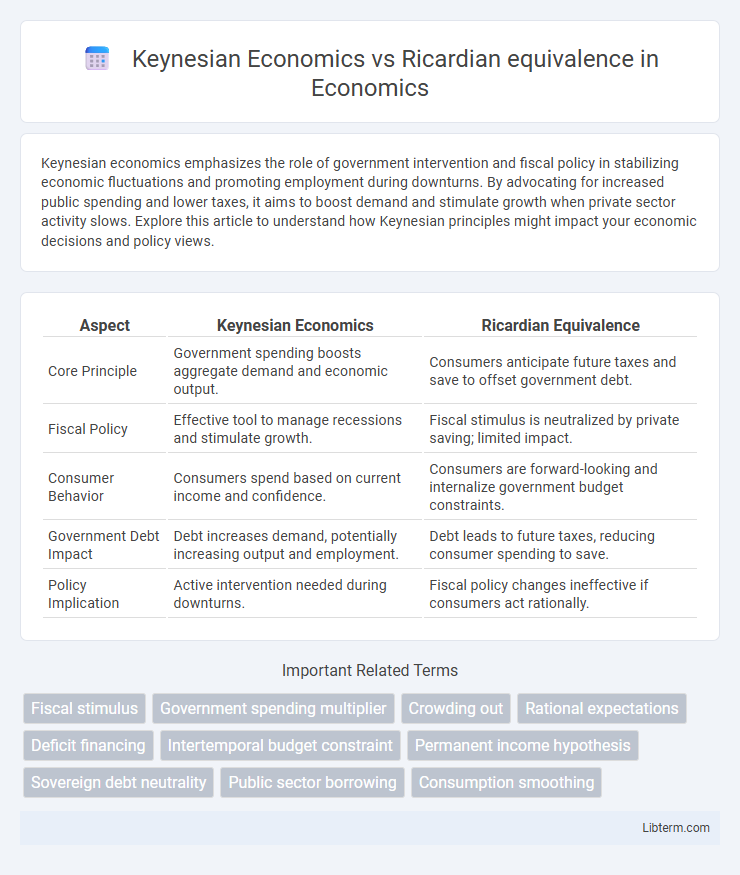Keynesian economics emphasizes the role of government intervention and fiscal policy in stabilizing economic fluctuations and promoting employment during downturns. By advocating for increased public spending and lower taxes, it aims to boost demand and stimulate growth when private sector activity slows. Explore this article to understand how Keynesian principles might impact your economic decisions and policy views.
Table of Comparison
| Aspect | Keynesian Economics | Ricardian Equivalence |
|---|---|---|
| Core Principle | Government spending boosts aggregate demand and economic output. | Consumers anticipate future taxes and save to offset government debt. |
| Fiscal Policy | Effective tool to manage recessions and stimulate growth. | Fiscal stimulus is neutralized by private saving; limited impact. |
| Consumer Behavior | Consumers spend based on current income and confidence. | Consumers are forward-looking and internalize government budget constraints. |
| Government Debt Impact | Debt increases demand, potentially increasing output and employment. | Debt leads to future taxes, reducing consumer spending to save. |
| Policy Implication | Active intervention needed during downturns. | Fiscal policy changes ineffective if consumers act rationally. |
Introduction to Keynesian Economics
Keynesian Economics emphasizes government intervention through fiscal policy to stimulate demand and address economic fluctuations, advocating increased public spending and lower taxes during recessions. It challenges the notion that individuals will offset government deficits by saving more, contrasting with Ricardian equivalence, which suggests that consumers anticipate future taxes and adjust their savings accordingly. Keynesian theory prioritizes aggregate demand management as a tool to achieve full employment and economic stability.
Overview of Ricardian Equivalence
Ricardian equivalence is an economic theory proposing that government debt issuance does not affect overall demand because individuals anticipate future taxes needed to repay debt and adjust their savings accordingly. This concept challenges Keynesian economics by suggesting that fiscal stimulus through deficit spending is neutralized by increased private saving, thus having little impact on aggregate demand. The equivalence assumes rational, forward-looking agents who internalize government budget constraints, leading to minimal changes in consumption despite changes in fiscal policy.
Fundamental Principles of Keynesian Theory
Keynesian economics centers on the principle that aggregate demand drives economic output and employment, advocating for active government intervention through fiscal policy to manage demand fluctuations. It emphasizes that during recessions, increased public spending can stimulate economic activity and reduce unemployment, counteracting insufficient private demand. This approach contrasts with Ricardian equivalence, which posits that consumers anticipate future taxes from government borrowing and therefore save rather than spend additional income, undermining fiscal stimulus effectiveness.
Key Assumptions of Ricardian Equivalence
Ricardian equivalence assumes that consumers are forward-looking and perfectly rational, anticipating future taxes resulting from government debt, leading them to increase savings to offset public borrowing. It presupposes intergenerational altruism, where current consumers consider the welfare of future generations when making consumption decisions. The hypothesis relies on perfect capital markets without borrowing constraints, allowing consumers to smooth consumption over time regardless of government fiscal policy.
Government Spending: Keynesian vs Ricardian Perspective
Keynesian economics advocates that increased government spending stimulates aggregate demand, leading to higher output and employment, especially during economic downturns. In contrast, Ricardian equivalence theory argues that consumers anticipate future taxes resulting from government debt, causing them to save rather than spend, thereby neutralizing the stimulative effect of government expenditure. Empirical evidence on the effectiveness of fiscal stimulus remains mixed, with Keynesian policies favoring active fiscal intervention and Ricardian views emphasizing the neutrality of deficit financing.
Taxation and Consumer Behavior in Both Models
Keynesian economics posits that taxation directly influences consumer behavior by altering disposable income, leading to changes in aggregate demand and overall economic activity. In contrast, Ricardian equivalence suggests that consumers anticipate future tax liabilities linked to government borrowing and therefore increase savings to offset current tax cuts, neutralizing the impact on aggregate demand. This fundamental difference highlights Keynesian support for fiscal stimulus through tax policy, while Ricardian equivalence implies limited effectiveness of such interventions on consumption patterns.
Fiscal Policy Effectiveness: Contrasting Views
Keynesian economics asserts that fiscal policy, through government spending and tax adjustments, directly influences aggregate demand, effectively stimulating economic activity during downturns. In contrast, Ricardian equivalence argues that consumers anticipate future tax liabilities from government borrowing, leading them to save rather than spend increased government transfers, which neutralizes fiscal stimulus effects. Empirical evidence often supports Keynesian views in the short term, while Ricardian equivalence highlights long-term limitations on fiscal policy effectiveness.
Real-World Applications and Historical Evidence
Keynesian economics advocates for active government intervention through fiscal stimulus to boost aggregate demand during economic downturns, as demonstrated by the New Deal policies in the 1930s and post-2008 recession stimulus packages. Ricardian equivalence posits that rational consumers anticipate future tax liabilities, neutralizing the effects of government borrowing on aggregate demand, but empirical studies often find limited support for this hypothesis in real-world economies. Historical evidence from the Great Depression and recent economic crises suggests that fiscal multipliers are typically positive, indicating that government spending can influence economic output contrary to the predictions of Ricardian equivalence.
Criticisms and Limitations of Each Theory
Keynesian economics faces criticism for potentially leading to prolonged government deficits and inflation due to its emphasis on fiscal stimulus, which may crowd out private investment. Ricardian equivalence is limited by its assumption of perfectly rational consumers who fully internalize government budget constraints, ignoring behavioral factors and credit market imperfections. Both theories struggle to account for real-world complexities such as varying consumer expectations and institutional constraints on fiscal policy effectiveness.
Conclusion: Synthesizing the Macroeconomic Debate
Keynesian economics emphasizes active government intervention through fiscal policy to manage economic fluctuations, asserting that increased public spending can stimulate aggregate demand and reduce unemployment. Ricardian equivalence challenges this by arguing that consumers anticipate future taxation to repay government debt, thus offsetting the intended stimulative effects of fiscal deficits. Synthesizing these perspectives highlights the nuanced impact of fiscal policy, where effectiveness depends on consumer behavior assumptions, economic context, and institutional frameworks influencing demand-side responses.
Keynesian Economics Infographic

 libterm.com
libterm.com